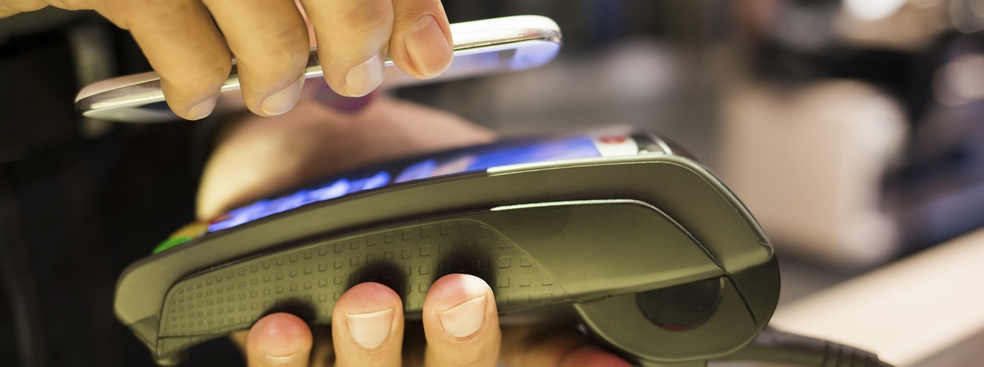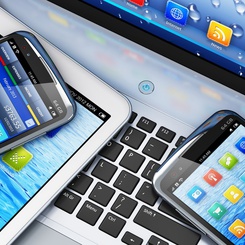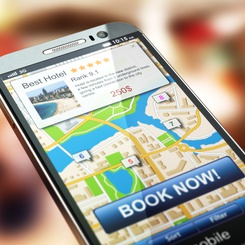With Tuesday’s much-anticipated event, Apple has unveiled some beautiful and exciting new products: The iPhone 6 has a bigger, 4.7-inch screen, Retina HD resolution display, a smooth, rounded design and a better camera. The iPhone 6 Plus with a 5.5 inch screen has all that, plus optical image stabilization and an even bigger battery. The long-anticipated Apple Watch, with a similar slick design, got the biggest reaction from the crowd. All three devices are in line with Apple’s high design standards in terms of intuitive interface, luxury feel and aesthetic appeal.
Apple Pay, which uses Near Field Communication (NFC) technology to let these devices conduct payments in the physical world, was in my opinion, the most exciting news of the day. Apple is finally getting into the mobile NFC payment game, and will surely have a huge impact on the industry as a whole. In short, Apple Pay will let users virtualize their credit card in their iPhone 6, and at selected merchants, pay for purchases by just waving the iPhone or Apple Watch to the payment terminal. Apple already boasts a long list of merchant partners, in addition to partnerships with all of the major credit card companies and US banks.
Suffice it to say that a lot of buzz has been generated in the hours since the launch. One could argue that it was the most exciting launch since Steve Job’s last keynote. And at any rate, it was a milestone for Tim Cook, who has now launched something entirely new for Apple, and set a future course for the company.
The ‘haters’ might say: “Bigger screens? Smart watches? Mobile payments? It’s all been done before!” This, of course, is true. Apple is technically ‘late’ on these innovations, by a few years, even. Companies like Samsung have been offering handsets with larger screens for ages, the Samsung Galaxy Gear is more than a year old, and Google Wallet has been around since 2011. So, despite the excitement generated by Tuesday’s event, should we be asking ourselves if Apple is no longer the trailblazing company it once was? Or Apple has simply adopted a different innovation strategy to face tough competition?
In fact, Apple’s secret weapon is not really anymore its ability to be the first mover with a radical innovation. It is the company’s meticulous attention to detail. Their products are slick, beautiful and fit within a seamless, and intuitive ecosystem of complementary products and services. With Tuesday’s announcement – and in true Apple fashion – they have improved existing technologies and generated a lot of buzz along the way. This is what Apple does best.
How is Apple one-upping its competitors with these new products? Where the handset is concerned, as usual, they are offering a high-end item, made of glass and steel, and to which most of the competing handsets cannot compare in terms of finishing quality. And by offering a larger handset, Apple will be able to boost their appeal in Asian markets, where larger handsets typically outsell the stand-sized models. Design is also a huge plus for the Apple Watch that is light, practical, customizable, and elegant.
But Apple Pay is the real game-changer. Like Google Wallet, it allows for both in-store and in-app payment. American Express, MasterCard and Visa are all partners, in addition to support from financial institutions like Bank of America and Chase. Apple has secured some merchant partners - including Bloomingdale’s, Disney, Macy’s and McDonalds – but this list will need to grow fast if Apple Pay is to really take off. Attracting the largest US merchants (e.g., Walmart, Target, Best Buy, CVS) might still be a challenge as a dozen of them already formed an alliance called Merchant Customer Exchange (or MCX) in 2012 and just launched their own mobile wallet under the brand CurrentC.
What makes Apple Pay different from Google Wallet is the data privacy: while Google wallet analyses user activity in order to improve their ad targeting and generate more revenues, Apple claims that it will not know what Apple Pay users buy, or how much they pay for it. At the end, this is not surprising as Google’s business model is about advertising while Apple is mostly about selling hardware.
Even though, for now, there is no clear incentive for Apple customers and merchants to use Apple Pay – Apple will likely capitalize on the “cool factor”, as they have done in the past. Plus, when considering the EMV contactless terminal transition happening right now, we can easily see how an NFC-enabled iPhone with Apple Pay has a real chance of widespread adoption. And as a side-note, one might ask what is to become of PayPal if Apple Pay does take off.
We can also wonder what will happen to Apple if PayPal Pay really takes off. Also, other competitors such as Samsung will work to get a product to offer both integrated into their mobile devices, in the more generally fragmented Android ecosystem. Ultimately, it is the mobile operators that have been most heavily impacted by the announcement of the Apple Pay. Indeed, the NFC architecture used by Apple does not really appeal to their service. After losing control of the market for mobile applications, it's still a missed opportunity for them to capture additional revenue with mobile value-added services. That said, the United States, mobile operators have formed an alliance called SoftCard (formerly ISIS) that will be in direct competition with Apple Pay. A recent announcement says that Apple will allow operators to offer their mobile wallet to iPhone users. The real question will be what business arrangement will be implemented. What is certain is that by imposing this new NFC architecture, the bargaining power is now passed into the hands of Apple.
Of course, there are still some questions up in the air. In the wake of the recent iCloud leak, one of the biggest questions on peoples’ minds is security. Apple really insisted on this during Tuesday’s presentation. Apple has been clear on added security features and privacy regarding purchases and activity. Reassuring consumers about this will be a major hurdle over the coming months.
Only the future will tell if Apple’s current innovation strategy is sustainable in the long run. Until now, Apple has incrementally added enough value to maintain consumers’ loyalty. However, in the meantime, competitors have been working hard to improve their products and services to eventually reach Apple’s design standards. Some of them are even getting enough traction to convert hardcore Apple customers. Who knows… Maybe a fast-moving challenger such as Xiaomi could beat the champion Apple at its own game. One thing for sure, the competition is on and we can expect some announcements from competitors in the coming months.




